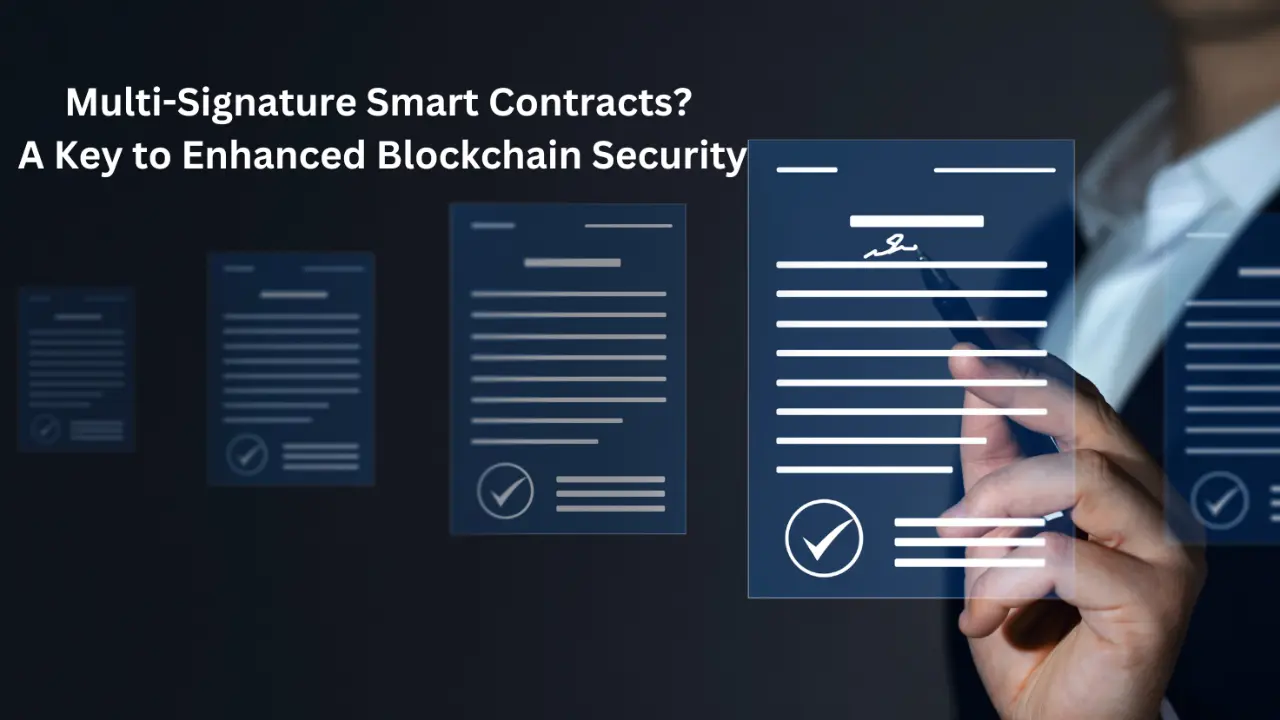Multi-Signature Smart Contracts? A Key to Enhanced Blockchain Security

Blockchain adoption continues to grow as industries recognize its potential to streamline operations and secure digital assets. Smart contracts play a pivotal role in blockchain networks by automating agreements without intermediaries. However, many of these contracts rely on single-key authentication, creating vulnerabilities that can be exploited in high-value or multi-stakeholder transactions.
Multi-signature (multi-sig) smart contracts offer a robust solution to this challenge. They require approvals from multiple parties to authorize actions, reducing risks and enhancing trust. This blog explores how multi-sig smart contracts work, their benefits, and their applications in blockchain ecosystems.
Smart Contracts: The Foundation of Blockchain Automation
Smart contracts automate agreements and execute predefined conditions without the need for third parties. These contracts operate on blockchain networks, ensuring transparency, immutability, and security.
For example, in supply chain management, a smart contract can automatically release payments when IoT sensors confirm that a shipment has arrived at its destination. The automation eliminates human error and ensures compliance with the agreed terms.
Despite these benefits, most smart contracts depend on a single private key for control. This reliance creates a single point of failure, increasing the risk of theft or unauthorized access if the keyholder's credentials are compromised.
What Are Multi-Signature Smart Contracts?
Multi-signature smart contracts address the limitations of single-key systems by requiring multiple parties to approve transactions. These contracts use cryptographic signatures to enforce shared control, making unauthorized actions significantly harder to execute.
How Multi-Sig Works
In a traditional smart contract, one private key can authorize all actions. Multi-sig contracts distribute control across several parties, introducing a layer of collective decision-making.
2-of-3 Multi-Sig: Three parties hold private keys, but only two approvals are needed to authorize a transaction.
3-of-5 Multi-Sig: Five parties have access, and any three can approve a transaction.
These configurations offer flexibility and security, making them ideal for industries requiring collaborative decision-making or managing sensitive assets.
Advantages of Multi-Signature Smart Contracts
Eliminating Single Points of Failure
Multi-sig contracts reduce the risks associated with single-key systems. For example, in a 2-of-3 setup, if one key is compromised, the attacker still requires another key to proceed, significantly enhancing the contract's security.Minimizing Insider Threats
By requiring multiple approvals, multi-sig contracts prevent any one individual from acting unilaterally. This oversight is especially important in corporate environments, where internal fraud can have devastating consequences. A corporate treasury, for instance, may require multiple board members to sign off on transactions, ensuring checks and balances.Strengthening Defense Against External Attacks
External threats, such as hacking attempts, face additional barriers in multi-sig setups. Even if an attacker obtains one key, they cannot execute the contract without gaining access to the required number of keys. This layered approach significantly improves the security of high-stakes transactions.Promoting Transparency and Accountability
Multi-sig contracts log the involvement of all participants in a transaction. This accountability ensures that every action is traceable, which can deter fraud and build trust among stakeholders.Enabling Flexible Access Control
Multi-sig contracts strike a balance between security and operational continuity. For example, in a 3-of-5 configuration, the system remains functional even if one or two keyholders are unavailable. This flexibility prevents delays while maintaining security standards.
Real-World Applications of Multi-Signature Smart Contracts
1. Securing Cryptocurrency Wallets
Multi-sig wallets enhance the security of digital assets by requiring multiple approvals. In a typical 2-of-3 setup:
The user holds one key.
The wallet provider holds another.
A backup key adds an extra layer of security.
This structure protects funds even if one key is compromised, ensuring users retain control over their assets.
2. Managing Corporate Treasuries
Organizations managing on-chain funds use multi-sig contracts to secure their financial operations. By requiring approvals from multiple executives or board members, companies can prevent unauthorized transactions and distribute decision-making responsibilities.
3. Facilitating Partnerships and Joint Ventures
Multi-sig contracts enable secure collaboration in partnerships. For example, three partners in a joint venture can use a 2-of-3 multi-sig wallet to ensure that funds are only accessible with at least two approvals. This approach safeguards shared assets and builds trust among partners.
4. Supporting Decentralized Governance in DAOs
Decentralized Autonomous Organizations (DAOs) rely on collective decision-making. Multi-sig contracts align with this model by requiring multiple members to approve transactions. This structure prevents any single participant from gaining excessive control and upholds the DAO's principles of decentralization.
Security Benefits in High-Stakes Transactions
DeFi Applications
Decentralized finance (DeFi) platforms manage large volumes of digital assets, making them attractive targets for hackers. Multi-sig contracts offer an additional layer of protection by requiring multiple approvals before funds can be moved.
Corporate Finance
Large organizations often deal with complex financial transactions that require stringent oversight. Multi-sig contracts ensure that sensitive operations, such as transferring large sums or managing escrow accounts, involve multiple approvers to reduce the likelihood of errors or malicious actions.
Collaborative Projects
In projects involving multiple stakeholders, multi-sig contracts ensure fairness and transparency. For example, a 3-of-5 setup can manage project funds, allowing decisions to reflect the consensus of key participants.
Overcoming Potential Challenges
While multi-sig contracts offer significant advantages, they require careful implementation:
Coordination: All parties involved must understand their roles and responsibilities.
Key Management: Losing multiple keys can render funds inaccessible. Secure backup systems are essential.
Smart Contract Design: Developers must ensure the contract’s code is free of vulnerabilities to maintain trust and functionality.
Conclusion
Multi-signature smart contracts are essential tools for enhancing blockchain security. By distributing control among multiple parties, they mitigate risks such as insider threats, external attacks, and single points of failure. These contracts offer practical applications across cryptocurrency wallets, corporate finance, decentralized governance, and joint ventures.
As blockchain adoption grows, multi-sig contracts will play a critical role in protecting digital assets and fostering trust in decentralized ecosystems. By embracing these tools, organizations and individuals can ensure their transactions remain secure, transparent, and resilient.